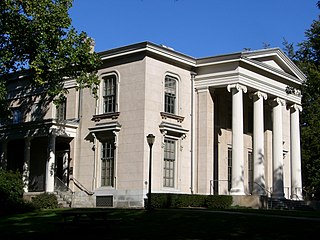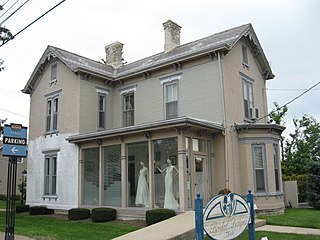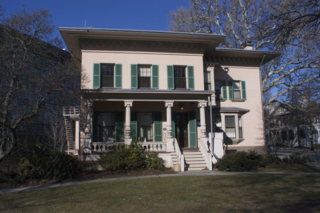
Wooster Square is a neighborhood in the city of New Haven, Connecticut to the east of downtown. The name refers to a park square located between Greene Street, Wooster Place, Chapel Street and Academy Street in the center of the neighborhood. Wooster Square is also known as Little Italy: a bastion of Italian American culture and cuisine, and is home to some of New Haven's, best-known pizza eateries, including Frank Pepe Pizzeria Napoletana and Sally's Apizza. The square and much of the neighborhood are included in the Wooster Square Historic District, which was listed on the National Register of Historic Places in 1971.

Arthur Edson Blair Moody, known as Blair Moody, was a journalist and Democratic U.S. Senator from the state of Michigan.
Fair Haven Heights, or simply the Heights, is a residential and light industrial neighborhood in the eastern part of the city of New Haven, Connecticut, located east of the Quinnipiac River. Fair Haven Heights is not to be confused with the adjacent Fair Haven neighborhood west of the river. The area is bordered on the west by the Quinnipiac River, on the north by Route 80, on the east by the town of East Haven, and on the south by Ferry Street and Warwick Avenue. The main through routes are Quinnipiac Avenue, East Grand Avenue, and Eastern Street

Hillhouse Avenue is a street in New Haven, Connecticut, famous for its many nineteenth century mansions, including the president's house at Yale University. Both Charles Dickens and Mark Twain have described it as "the most beautiful street in America." Much of the avenue is included in the Hillhouse Avenue Historic District, which extends to include houses on adjacent streets.

The Blair House is a historic house in the city of Montgomery, Ohio, United States. One of the best examples of Victorian-period Italianate architecture in the city, it was built for butcher James Blair and his wife Anne in 1875. A brick structure with a slate roof, it is a two-story structure built in the plan of the letter "L." Among its distinctive architectural elements are the ornamented single-story bay, the brackets that support the eaves of the roof, and the corbelled chimneys.

The James Dwight Dana House, also known as the Dana House, is a historic 19th-century Italianate house at 24 Hillhouse Avenue in New Haven, Connecticut, in the United States. This building, designed by New Haven architect Henry Austin, was the home of Yale University geology professor James Dwight Dana (1813–95). It was declared a National Historic Landmark in 1965 for its association with Dana, who produced the first published works emphasizing that the study of geology was a much broader discipline than the examination of individual rocks.

The Whitney Avenue Historic District is a historic district in the East Rock neighborhood of New Haven, Connecticut. It is a 203-acre (82 ha) district which included 1,084 contributing buildings when it was listed on the National Register of Historic Places in 1989.

The Dr. Charles Jordan House is a historic house at 9 Jordan Avenue in Wakefield, Massachusetts. Built c. 1885, it is one Wakefield's most elaborate Queen Anne Victorian houses. The 2+1⁄2-story wood-frame house is unusual for having a hipped roof; it also has a tower in the northwest corner, and a porch with Italianate pillars brackets. The house was built by Dr. Charles Jordan, a local physician and pharmacist with extensive land holdings in the area.
Andrew Jackson Warner, also known as A. J. Warner, was a prominent architect in Rochester, New York.

The Hayward House is a historic house at 9 Hayward Avenue in Colchester, Connecticut. Built in 1775 and embellished in the late 19th century, it is a well-preserved 18th-century house, which has seen a number of locally prominent residents, as well as the nationally known inventor Nathaniel Hayward, who developed the process of vulcanizing rubber. The house was listed on the National Register of Historic Places in 1972.

Temple Beth Israel is a historic Jewish synagogue building at 21 Charter Oak Avenue in Hartford, Connecticut. Built in 1875-76, it is the oldest purpose-built synagogue building in the state. The building was listed on the National Register of Historic Places in 1978. After being rescued from threatened demolition, it now houses a local cultural center. The congregation, established in 1843, is now located at a synagogue in West Hartford.
Ehrick Kensett Rossiter was an American architect known for the country homes he designed.

The Deacon John Davenport House is a historic house at 129 Davenport Ridge Road in Stamford, Connecticut, United States. Built in 1775, it is significant for its architecture and for its association with the locally prominent Davenport family, descended from John Davenport, one of the founders of New Haven. The house was listed on the National Register of Historic Places in 1982.

The Mary and Eliza Freeman Houses are historic residences in Bridgeport, Connecticut. The simple, clapboard-covered dwellings were built in 1848 in what became known as Little Liberia, a neighborhood settled by free blacks starting in the first quarter of the nineteenth century. As the last surviving houses of this neighborhood on their original foundations, these were added to the National Register of Historic Places on February 22, 1999. The houses are the oldest remaining houses in Connecticut built by free blacks, before the state completed its gradual abolition of slavery in 1848. The homes and nearby Walter's Memorial A.M.E. Zion Church are also listed sites on the Connecticut Freedom Trail.
Charles Amadon Moody was an American author and book reviewer. He co-edited Out West with Charles Fletcher Lummis for several years in the 1900s.

The Union School is a historic school building at 174 Center Street in West Haven, Connecticut. Built in 1890, when the area was still part of Orange, it was West Haven's first brick school building, serving as a grammar school and high school for generations of local students. Now a senior living facility, it was listed on the National Register of Historic Places in 1987.

The Dr. Andrew Castle House, also known as the Castle-Russell House, is a historic house at 555 Amity Road in Woodbridge, Connecticut. Built in 1838, it is a locally distinguished example of high-style Greek Revival architecture, and is notable as the home of three prominent local physicians. It was listed on the National Register of Historic Places in 2000.

The Jonathan Dickerman II House is a historic house museum at 105 Mt. Carmel Avenue in Hamden, Connecticut. Built about 1795 by the grandson of an early settler of the area, it is a well-preserved and unusual example of late Georgian architecture. It was listed on the National Register of Historic Places in 1982. It is now owned and operated by the Hamden Historical Society.

Mary Jane Blair Moody was an American physician, anatomist and editor. She was the first woman to receive a degree from Buffalo Medical College, the first woman to be a member of the American Association of Anatomists, and one of the first women to practice medicine in New Haven, Connecticut. Her home there is listed on the National Register of Historic Places as the Dr. Mary B. Moody House.

The Saginaw Central City Historic Residential District is a primarily residential historic district located in Saginaw, Michigan and roughly bounded by Federal Avenue, South Baum Street, Park Avenue, and Hoyt Avenue. The district was listed on the National Register of Historic Places in 1979.



















